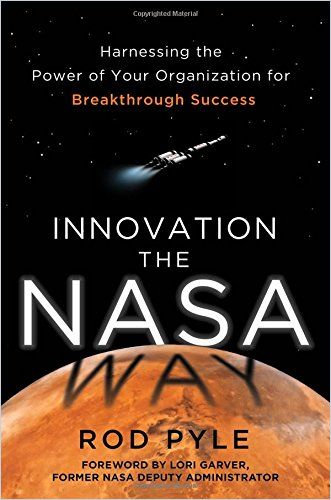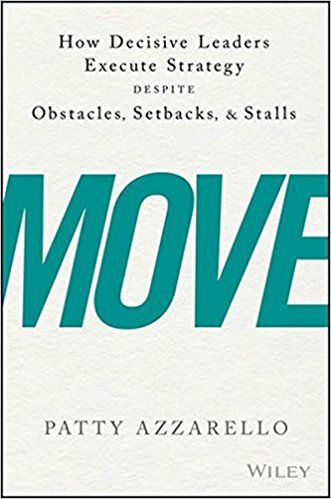Great Expeditions

During an earlier age, explorers like Christopher Columbus, Vasco da Gama and Ferdinand Magellan led grand expeditions to discover the world and its riches. In the current era, hailed by the World Economic Forum as the Fourth Industrial Revolution, companies must launch equally ambitious forays into an unknown future. It’s like the Age of Exploration all over again, only now the seas are transformational digital technologies like the Internet of Things, artificial intelligence (AI), robotics and 3D printing. Leading change in your organization is like leading an expedition – a big, fraught, exciting journey. Here is a blueprint to guide your corporate journey through the seas of constant change.
1. Pick a Direction
Branding expert Craig Wilson’s purpose, as described in his book The Compass and the Nail, was to create loyal customers for outdoor clothing company Patagonia. He advocates finding a “true north” for your company by aligning with your core values, mapping business interactions and integrating your principles into your brand story. Start with identifying your core customer base and understand why they choose you.
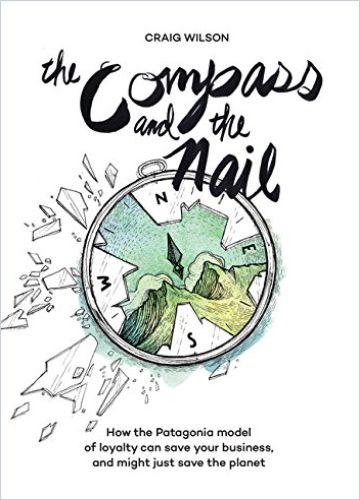
In the early 20th century, explorer Earnest Shackleton chose south: Antarctica. He’d already set records for going to the southernmost latitude in 1901-1904 and 1907-1909. His goal was the South Pole, but another explorer, Roald Amundsen, beat him to it in 1911. So Shackleton shifted his goal to being the first to cross the continent on foot. His expedition set sail in 1914.
We have to understand our own beliefs and purpose before we can connect with others about them. We need to know why we do what we do before we can explain how we do it or what we do.
Craig Wilson
In Agent of Change, authors James Watson and Denis McCauley advocate putting your workforce at the center of transformation, especially when looking at digital adaptations. In How To Fix a Factory, author Rob Tracy emphasizes the steps to take to build the motivation for change:
- Inspire your workforce to participate in the transition you propose.
- Keep stakeholders updated on your progress.
- “Unify leadership.” If need be, hire an expert to help with this goal.
- Understand that leaders set the pace of change for a skilled team; in times of turbulence, though, the leader’s primary goal is navigating through chaos.
Change will only happen if the leadership team and the workforce are ready to embrace change and unite toward a common goal.
Rob Tracy
For large, complex organizations looking at digital transformation, beware the drag of legacy thinking and incrementalism warns Roland Deiser in “Digital Transformation Challenges in Large and Complex Organizations.”

Digital Transformation Challenges in Large and Complex Organizations
Center for the Future of Organization2. Chart Your Course
Perhaps more important than setting a future goal is to establish a questing framework for your company. In How to Lead a Quest, author Jason Fox suggests a mind-set that embraces the “tension of uncertainty” and veers from what might seem like the logical, “default” path. Resisting the urge to implement quick fixes leads to sharper thinking. Think more like a start-up.
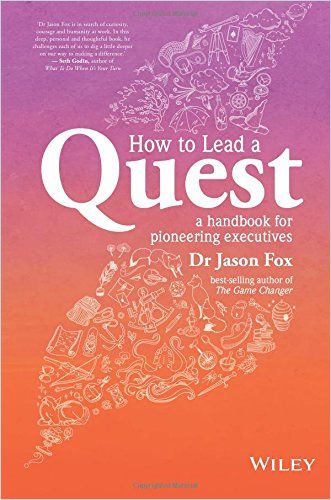
By seeking to reduce uncertainty – instead of questing within it – we end up reducing the very things that allow us to pioneer and unlock game-changing strategic innovation: creativity, serendipity, imagination, diversity, experimentation and learning.
Jason Fox
Authors Gregory P. Shea and Cassie A. Solomon note in Leading Successful Change that for large organizations, transformation means changing the behavior of thousands of people across departments and spread across the world.
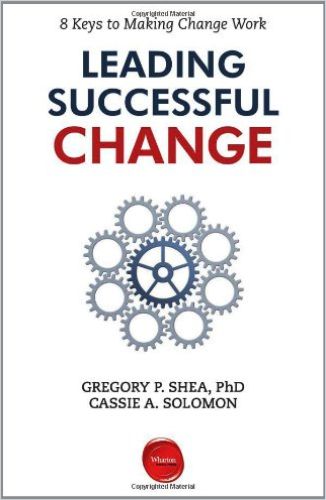
They suggest imagining future scenarios will help your organization pinpoint the behaviors you’re trying to change. The more detailed this scene making of desired future workplace interactions, the better. Set up processes to measure progress and be sure you continue to be in alignment with company goals.
Scene making allows you to identify the end-point behaviors that will mark a successful transformation. Those behaviors, in turn, give you a point to work back from, toward the present.
Gregory P. Shea and Cassie A. Solomon
If your Antarctica is adapting your business to take advantage of digital innovations in your sector, then get an overview of the challenging landscape that awaits with this Boston Consulting Group report on “The Bionic Company.”
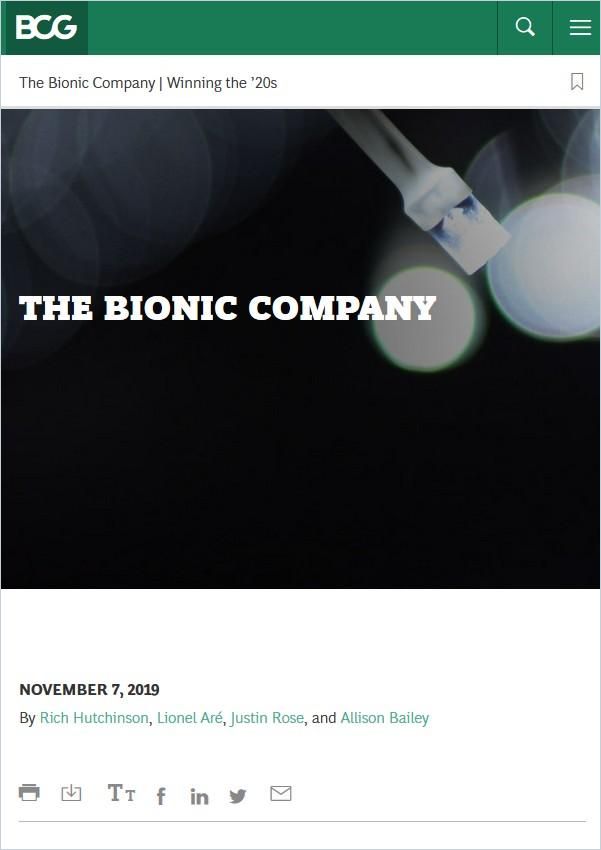
In the not-very-distant future, almost all business processes and operations will be heavily augmented, or even operated, by machines, many of which will be running AI algorithms.
Boston Consulting Group
3. Check Your Resources
In “What Does a Successful Digital Ecosystem Look Like,” Boston Consulting Group recommends you check your business “ecosystem” when contemplating digital change. Too often leaders envision ambitious change goals without much thought about who will execute them and how. That’s why it’s important from the beginning to include feedback from your workforce. Sometimes the changes managers contemplate don’t make sense on the front lines of the business. These are questions you want answers to before you set out.
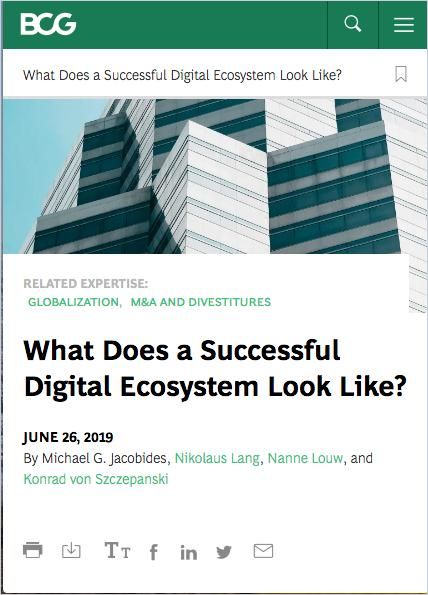
What Does a Successful Digital Ecosystem Look Like?
The Boston Consulting GroupSending change disciples out to do hard labor without concomitant attention by leaders to work systems essentially strands those disciples.
Boston Consulting Group
You’re going to need top talent. Expect change to affect every department. Pay attention to building agile teams and putting the digital talent you need in place. Anand Swaminathan and Jürgen Meffert point out in Digital @ Scale that in the digital era, all businesses are actually two businesses: the work they do and the data they create. As you contemplate your digital shift, the first talent hire should be a Chief Digital Officer.
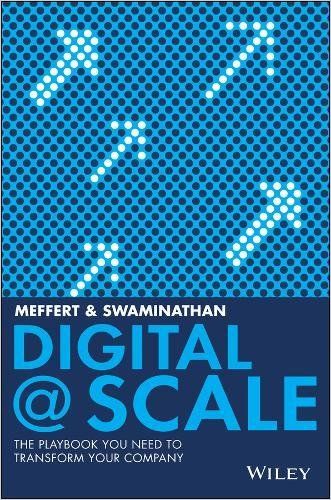
A CDO with reach and authority – a Steve Jobs for every company – can help to break down the functional silos, and shape the journey toward digitization as a permanent disruptor.
Anand Swaminathan and Jürgen Meffert
Google supports its commitment to continuous innovation by providing its workforce “slack resources,” namely, time, technology and support from mentors and experts. The company pays workers one day per week to freely work on new ideas without any pressure.
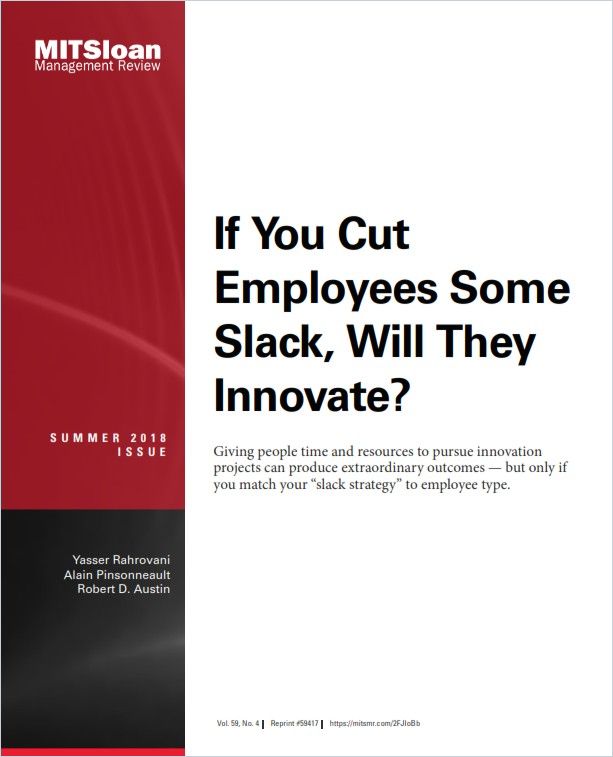
If You Cut Employees Some Slack, Will They Innovate?
MIT Sloan Management Review4. Create a Conversation
All “business is a conversation” at heart. Foster constant formal and informal conversation. Change requires robust and open lines of communication that span the organization and reach out to all stakeholders. Informal Learning author Jay Cross says think about the “learnscape” your company creates and how easy or difficult you make it for employees to upgrade their skills.
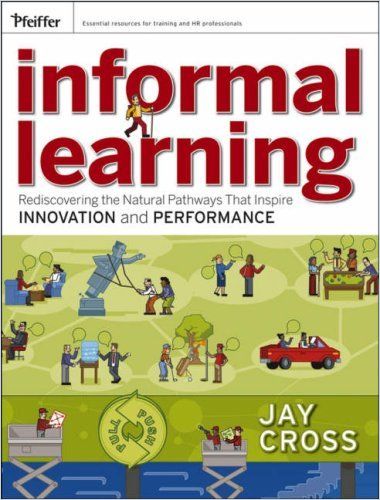
In Ignite Change, authors Nancy Duarte and Patti Sanchez recommend beginning big change processes with “Discovery Sessions” involving small groups of employees speaking openly about what changes they’d like to see in company culture. Above all, invoke empathy.
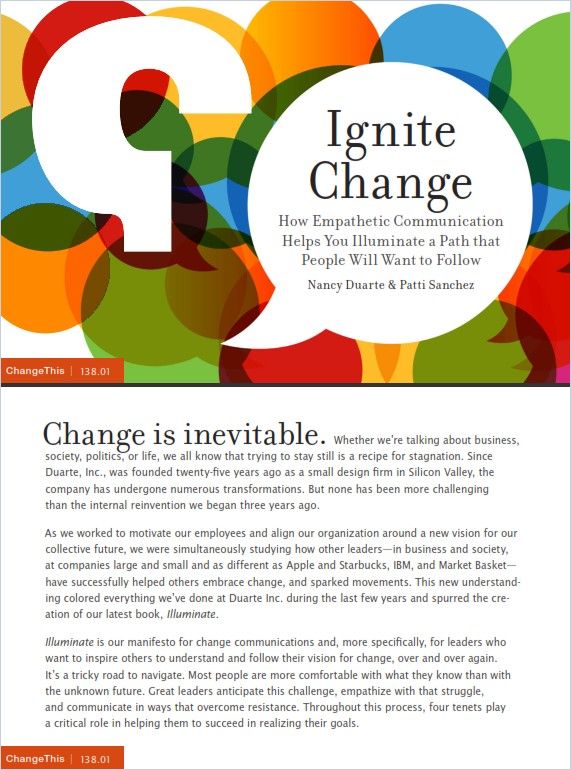
They view change as a “venture scape” through several phases, including a difficult “climb” phase, when the process of change seems to drag on and on. But this is when it’s most important for leaders to motivate others to keep pushing forward. Celebrating milestones and showing appreciation for contributions to them helps support morale.
5. Pay Attention to What Happens in the Middle
As the authors of Leading Successful Change stress, think about the people, processes and rewards that will drive forward progress. It’s better to make large, sweeping changes all at once than to drip it out slowly and lose momentum. Create the incentives you need and implement “nudge management” to provide the scaffolding for bold thinking and astute execution. Small “nudges” remind employees that their contribution is valued. “Digitally mature” companies think long-term, assemble cross-functional teams and support the career goals of talented workers. As an organization’s focus shifts, it’s up to leaders to demonstrate their unwavering commitment to change.
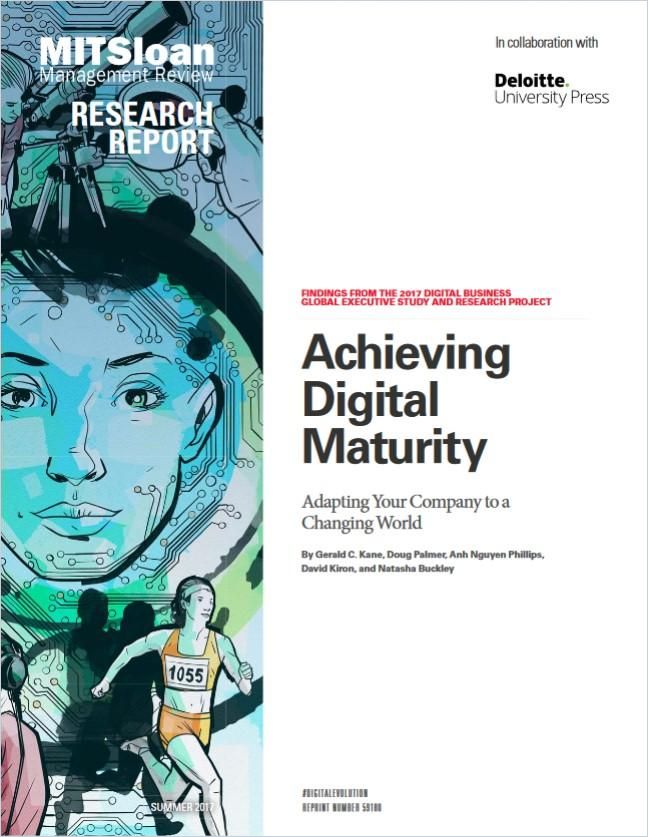
If you’re rapidly expanding, plan how you will scale your teams. In Scaling Teams, authors Alexander Grosse and David Loftesness recommend going into a period of rapid expansion with a “scaling plan” that integrates a hiring plan.
Digital maturity doesn’t develop accidentally, nor is it the result of a quick fix. Rather, digital maturity is achieved through commitment, investment and leadership.
MIT Sloan Management Review
6. The Map Is Not the Territory
Sometimes even the best laid plans go wrong. Explorer Earnest Shackleton set out to be the first person to trek across the continent of Antarctica, but fate intervened. Early in the expedition, Shackleton’s ship, Endurance, froze fast in the ice. The mission changed from crossing the Antarctic to staying alive. It’s when things go wrong that leadership matters most.

Shackleton led his men through a “relentless ongoing emergency” after the ice they were stuck in crushed their ship. His steady, accessible leadership style held the group together for two years until he and a small team made their way in a lifeboat across treacherous waters to get help. Many business writers hold up Shackleton as an extraordinary leader leading in the midst of crisis. He didn’t cross Antarctica, but he didn’t lose a single member of his crew.
Shackleton’s strategy is the antithesis of the old command-and-control models. His brand of leadership instead values flexibility, teamwork and individual triumph.
Margot Morrell and Stephanie Capparell
Joe Mascaro points out in “To Save Earth, Go to Mars,” that sometimes the true benefits of a moonshot goal are the technologies and proficiencies that evolve in its pursuit. In his example, the companies solving the problems presented by going to Mars are perfecting renewable energy, growing plants indoors and upgrading 3D printing technologies. This “lateral innovation” is an indirect approach to problem-solving with great promise in its own right.
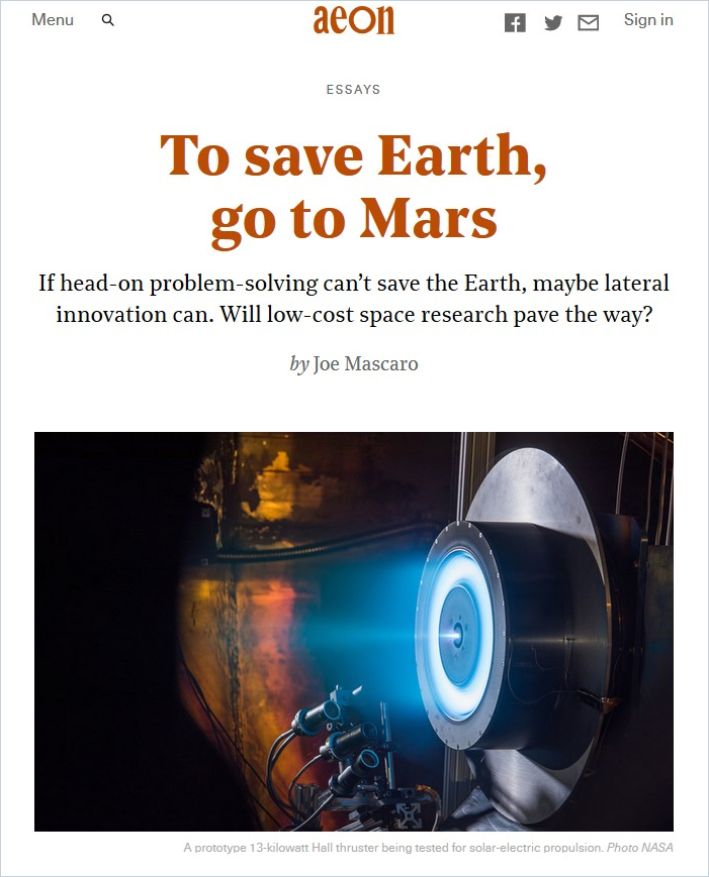
Watching what my colleagues do, and understanding why they do it, has convinced me that brute force alone will not innovate the technologies that will enable human civilization to become an effective arbiter of this planet and her resources.
Joe Mascaro
7. The Journey Was the Main Thing All Along
Leading Meaningful Change talks about the “culture shift” that comes with big change. Creating the right culture, say Roger Connors and Tom Smith in Change the Culture, Change the Game, requires the collaboration of everyone in an organization. It’s a co-creation. And “the right culture produces the right results.”
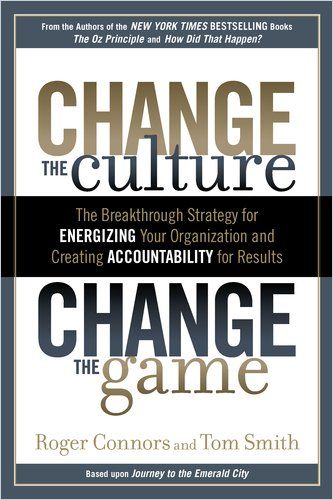
Effective leaders…manage change in ways that get a culture aligned with results, and…they work to keep it aligned.
Roger Connors and Tom Smith

